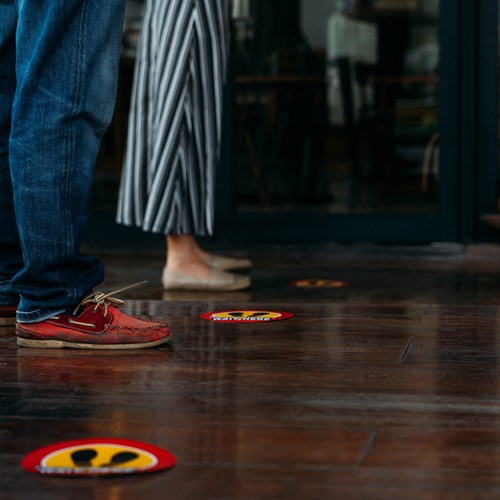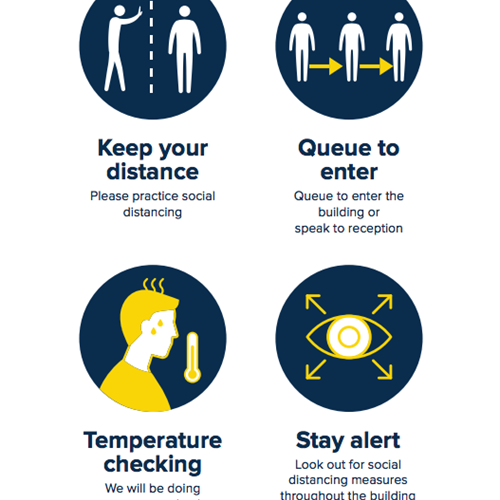Steps to operating a safe workplace
17 June 2020
Our guide will take you through the key steps to safely reopen and ensure the health and safety of your colleagues and customers.
This page was updated on 24 September 2020.
Safeguarding the health, safety and wellbeing of your employees, whilst instilling confidence in your customers is a key priority at this time. To help you safely operate during the pandemic, we've produced this step by step guide to support you.
Become COVID-19 safe – Business checklist
1. Conduct and display your Risk Assessment
Before you know whether you can open your doors, your first action is to conduct a risk assessment. The Centre for Assessment have developed a risk assessment toolkit, which includes a guide and a free template which you can access here.
Help to build confidence by sharing the Risk Assessment with your staff and publishing it on your website.
2. Support homeworking wherever possible
Determine who can continue working from home and provide support for these staff members. Flexibility will be crucial. Some employees might have children, others may have dependents to care for or they could be isolating – either way employers will have to communicate with staff and shape appropriate working arrangements.
Businesses can use our Guide to Remote Working to support their approach to agile working.
3. Provide good hygiene facilities at work
Before reopening/starting work
- Carry out usual cleaning procedures. Use disposable cloths and first clean surfaces with warm soapy water or detergent and then use a disinfectant to effectively sanitise the surface. Ensure your premises have a hot water supply to all sinks and basins, soap, disposable paper towels for hand drying and hand sanitiser where possible (minimum 60% alcohol).
- Check ventilation systems which may need to be serviced or adjusted
- Test specialist equipment which may not have been operated for awhile
- Where safe to do so, open windows and doors to improve ventilation and remove unnecessary contact points. Doors that need to remain closed could be fitted with hands-free devices.
During working hours
- Ensure frequent cleaning of work areas and surfaces regularly touched by individuals. This will include staff members and, depending on the work setting, potentially clients and suppliers
- Ensure frequent cleaning of equipment and objects between use. In some cases, employers could also consider limiting or restricting the use of high-touch items to further reduce risk of transmission through contaminated surfaces – this could include stationary, water bottles, phones etc
- Enforce a clear workspace policy at the end of the working day
- Consider the cleaning process for expensive equipment and machinery that cannot be washed down
- Ensure enhanced cleaning of showers, lockers and changing rooms and provide staff with guidance on how to use these shared spaces to follow social distancing measures
- Develop cleaning procedures for materials, merchandise and equipment entering your workplace
- Refer to the Cleaning in non-healthcare settings guidance for general principles of cleaning during the COVID-19 pandemic and in the event of a confirmed or suspected COVID-19 case.
Support good staff hygiene
- Display guidance to encourage frequent and good handwashing (for 20 seconds with soap and water)
- Remind staff to avoid touching their face and use tissues to cough or sneeze into, safely disposing them afterwards
- Provide frequent reminders to staff to maintain hygiene standards including washing clothes at the end of each day. If you have a uniform or dress code consider relaxing rules on enforcing this to ensure people can wear clean, washed clothing every day they come into the workplace
- Provide hand sanitiser in multiple locations and especially near “pinch points” such as entrances and exits
- Consider additional handwashing facilities (this is mostly applicable to construction settings)
4. Enable Social Distancing at work
- Provide guidance and reminders on social distancing – download our white labelled workplace signage pack for your workplace to ensure the correct social distancing measures are being communicated
- Where social distancing cannot fully be adhered to be sure to take appropriate actions to reduce the risk of transmission. This could include introducing screens or barriers to separate staff, stagger arrival and departure times and others
- Manage shift patterns and working groups effectively
- Display the government issued notice on your premises to show your staff and external stakeholders that you are COVID-19 secure
- Ensure you are following the latest government guidance on face coverings.
From 24 September, it will be compulsory for retail, leisure and hospitality staff to wear a face covering in areas that are open to the public and where they come or are likely to come within close contact of a member of the public
5. Play you part in easing the pressure on Public Transport
- Support staff who are required to travel to work. Transport for Greater Manchester has published guidance to inform employers and staff on how to safely travel during the pandemic
- Encourage the use of your Cycle to Work scheme if already in place or consider setting one up. This employee benefit scheme offers staff a cost-effective way to get new cycling equipment and is run through a salary sacrifice process
6. Manage visitors, suppliers and customers
- Visitors
- Encourage remote visits or meetings where possible
- Reduce unnecessary visits and limit the number of visitors onsite at any one time
- Allocate visitors specific meeting time slots
- If your business belongs to certain sectors, from 18 September, maintaining a record of all visitors for 21 days is required by law as this can be used to support the NHS Test and Trace initiative in the event of an outbreak. Our easy-to-read infographic outlines the information businesses in these sectors should collect and maintain. Further guidance is available on the government website
From 24th September, businesses in these sectors are also legally required to display official NHS QR code posters for visitors who have downloaded the Test and Trace App to scan in order to "check in" to your premises. - Review visitor protocol to ensure social distancing can be enforced. Implement protective screens in receptions areas and a digital sign in process to minimise contact
- Inform visitors of the social distancing and safety measures that you have put in place either on arrival with visual signage or prior via phone, email or website updates. Employers should also take into consideration the needs of those with protected characteristics, such as those who are visually impaired
- Review entrance and exit routes and consider implementing one-way systems to reduce risk of contact
- Train staff who will be hosting visitors to ensure COVID-19 safety guidance is followed
- Businesses in shared facilities should develop a coordinated approach with input from all tenants and the landlord. An example of this approach can be seen through Bruntwood's Return to Work Programme
- Suppliers and contractors
- Establish a COVID-19 safety protocol for receiving goods, merchandise and equipment and communicate to suppliers beforehand
- Minimise contact during delivery by introducing pick-up-drop-off zones and contactless receipt confirmation
- Determine if schedules can be revised to avoid visits from essential services and contractor coincide
- Customers
- Limit the number of customers depending on how many can reasonably follow the 2m or 1m with risk mitigation social distancing rule and use outdoor space to implement a queuing system
- Ensure you have a system in place to log details of customers, visitors and staff for NHS Test and Trace. From 18 September, this is a legal requirement. From Thursday 24 September you are also legally required to display official NHS QR code posters to allow customers to scan using the Test and Trace App and "check in" to your venue.
- Encourage the use of hand sanitiser upon entering the premises and urge customers to avoid handling items whilst browsing
- Establish safety measures such as implementing a one-way system and communicate these to customers. Employers should also ensure reasonable adjustments are made to accommodate disabled and visually impaired customers
- Facilitate and encourage contactless paying methods
- Adapt customer service in line with social distancing guidelines
- Ensure you are following the latest guidance on face coverings
For sector specific advice and guidance on working safely during coronavirus (COVID-19), visit the government’s dedicated webpage. A reopening tool is also available on the government website, here.
More information is available on the UK Government’s Coronavirus Business Support website. For more personalised advice call us on: 0161 237 4128 or email us at: BGH@growthco.uk
The information provided is meant as a general guide only rather than advice or assurance. GC Business Growth Hub does not guarantee the accuracy or completeness of this information and professional guidance should be sought on all aspects of business planning and responses to the coronavirus. Use of this guide and toolkit are entirely at the risk of the user. Any hyperlinks from this document are to external resources not connected to the GC Business Growth Hub and The Growth Company is not responsible for the content within any hyperlinked site.


